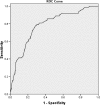Development and validation of a brief screening instrument for psychosocial risk associated with genetic testing: a pan-Canadian cohort study
- PMID: 23485718
- PMCID: PMC3612753
- DOI: 10.1136/bmjopen-2012-002227
Development and validation of a brief screening instrument for psychosocial risk associated with genetic testing: a pan-Canadian cohort study
Abstract
Objectives: To develop a brief, reliable and valid instrument to screen psychosocial risk among those who are undergoing genetic testing for Adult-Onset Hereditary Disease (AOHD).
Design: A prospective two-phase cohort study.
Setting: 5 genetic testing centres for AOHD, such as cancer, Huntington's disease or haemochromatosis, in ambulatory clinics of tertiary hospitals across Canada.
Participants: 141 individuals undergoing genetic testing were approached and consented to the instrument development phase of the study (Phase I). The Genetic Psychosocial Risk Instrument (GPRI) developed in Phase I was tested in Phase II for item refinement and validation. A separate cohort of 722 individuals consented to the study, 712 completed the baseline package and 463 completed all follow-up assessments. Most participants were female, at the mid-life stage. Individuals in advanced stages of the illness or with cognitive impairment or a language barrier were excluded.
Interventions: Phase I: GPRI items were generated from (1) a review of the literature, (2) input from genetic counsellors and (3) phase I participants. Phase II: further item refinement and validation were conducted with a second cohort of participants who completed the GPRI at baseline and were followed for psychological distress 1-month postgenetic testing results.
Primary and secondary outcome measures: GPRI, Hamilton Depression Rating Scale (HAM-D), Hamilton Anxiety Rating Scale (HAM-A), Brief Symptom Inventory (BSI) and Impact of Event Scale (IES).
Results: The final 20-item GPRI had a high reliability-Cronbach's α at 0.81. The construct validity was supported by high correlations between GPRI and BSI and IES. The predictive value was demonstrated by a receiver operating characteristic curve of 0.78 plotting GPRI against follow-up assessments using HAM-D and HAM-A.
Conclusions: With a cut-off score of 50, GPRI identified 84% of participants who displayed distress postgenetic testing results, supporting its potential usefulness in a clinical setting.
Figures
Similar articles
-
Assessing the acceptability, feasibility, and usefulness of a psychosocial screening tool to patients and clinicians in a clinical genetics service in Australia.J Genet Couns. 2022 Jun;31(3):653-662. doi: 10.1002/jgc4.1532. Epub 2021 Nov 17. J Genet Couns. 2022. PMID: 34788484
-
The Genetic Psychosocial Risk Instrument (GPRI): A Validation Study for European Portuguese.Acta Med Port. 2023 Mar 1;36(3):153-161. doi: 10.20344/amp.16497. Epub 2022 Jul 6. Acta Med Port. 2023. PMID: 35793339
-
The Talbieh Brief Distress Inventory: a brief instrument to measure psychological distress among immigrants.Compr Psychiatry. 1995 Nov-Dec;36(6):448-53. doi: 10.1016/s0010-440x(95)90253-8. Compr Psychiatry. 1995. PMID: 8565450
-
Novel Augmentation Strategies in Major Depression.Dan Med J. 2017 Apr;64(4):B5338. Dan Med J. 2017. PMID: 28385173 Review.
-
Psychosocial interventions for preventing and treating depression in dialysis patients.Cochrane Database Syst Rev. 2019 Dec 2;12(12):CD004542. doi: 10.1002/14651858.CD004542.pub3. Cochrane Database Syst Rev. 2019. PMID: 31789430 Free PMC article.
Cited by
-
100 years Lynch syndrome: what have we learned about psychosocial issues?Fam Cancer. 2013 Jun;12(2):325-39. doi: 10.1007/s10689-013-9653-8. Fam Cancer. 2013. PMID: 23670341 Review.
-
Distress, anxiety, and depression in persons with hereditary cancer syndromes: Results from a nationwide cross-sectional study in Germany.Cancer Med. 2023 Jun;12(12):13701-13711. doi: 10.1002/cam4.5999. Epub 2023 May 2. Cancer Med. 2023. PMID: 37132195 Free PMC article.
-
Genetic counseling and testing practices for late-onset neurodegenerative disease: a systematic review.J Neurol. 2022 Feb;269(2):676-692. doi: 10.1007/s00415-021-10461-5. Epub 2021 Mar 1. J Neurol. 2022. PMID: 33649871 Free PMC article.
-
Identification et prise en charge des femmes ayant des antécédents familiaux de cancer du sein: Guide pratique à l’intention des médecins.Can Fam Physician. 2016 Oct;62(10):e572-e577. Can Fam Physician. 2016. PMID: 27737991 Free PMC article. Review. French.
-
Telephone versus in-person colorectal cancer risk and screening intervention for first-degree relatives: A randomized controlled trial.Cancer. 2019 Jul 1;125(13):2272-2282. doi: 10.1002/cncr.32032. Epub 2019 Mar 12. Cancer. 2019. PMID: 30861097 Free PMC article. Clinical Trial.
References
-
- Lerman C, Croyle RT. Emotional and behavioral responses to genetic testing for susceptibility to cancer. Oncology (Williston Park) 1996;10:191–5, 9; discussion 200–2. - PubMed
-
- Bleiker EM, Hahn DE, Aaronson NK. Psychosocial issues in cancer genetics—current status and future directions. Acta Oncol 2003;42:276–86 - PubMed
-
- Wellisch DK, Lindberg NM. A psychological profile of depressed and nondepressed women at high risk for breast cancer. Psychosomatics 2001;42:330–6 - PubMed
-
- Broadstock M, Michie S, Marteau T. Psychological consequences of predictive genetic testing: a systematic review. Eur J Hum Genet 2000;8:731–8 - PubMed
LinkOut - more resources
Full Text Sources
Other Literature Sources

